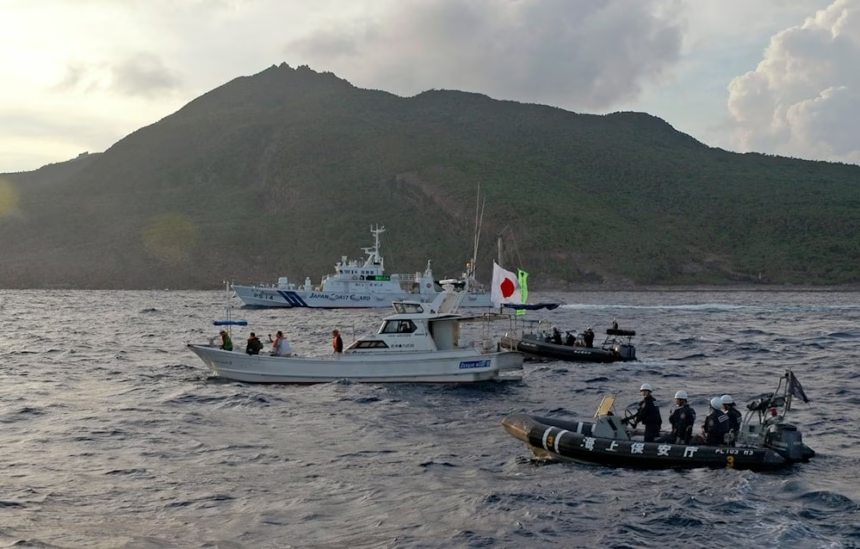TOKYO – China has stepped up pressure on Japan with another show of force near the disputed Senkaku Islands and fresh drone activity close to Japanese territory, sharpening tensions already rising over Taiwan.
On Sunday, 16 November 2025, China Coast Guard vessels moved through waters claimed and administered by Japan around the Senkaku Islands. Beijing described the move as a routine “rights enforcement operation,” but officials in Tokyo saw it as yet another calculated test of Japan’s patience and preparedness.
The patrol came soon after sharp exchanges between the two governments and coincided with reports of Chinese military drones flying close to Japan’s southwestern islands. Together, these actions have raised concern that the region is edging closer to a serious crisis, as China responds to Prime Minister Sanae Takaichi’s firm backing of Taiwan’s security.
The Senkaku Islands, a small group of uninhabited islets in the East China Sea, known in China as Diaoyu, have been a constant source of friction between Tokyo and Beijing. Japan has administered the area since 1972 and regards the islands as its territory, while China insists they belong to it and form part of its sovereign claims. The surrounding waters are believed to hold rich fishing grounds and possible energy reserves, adding economic weight to the dispute.
Sunday’s operation involved the China Coast Guard’s Vessel 1307 group, which Chinese state media hailed as a “lawful mission to uphold national sovereignty.” Japan Coast Guard ships tracked the Chinese vessels, blocked any attempt to land, and issued warnings, but could not stop the incursion into what Japan defines as its territorial sea.
This episode is only the latest in an intense pattern of activity. In fiscal year 2025 alone, Chinese Coast Guard ships have entered waters around the Senkaku Islands on more than 350 days, breaking previous records. Japanese officials say that this steady pressure has turned such incidents into a new normal, and describe it as “grey-zone aggression” that falls short of outright conflict but chips away at stability.
Chinese Military Drones Probe Japan’s Defences
Japan’s Defence Ministry reported that up to three Chinese military drones operated between Taiwan and Yonaguni Island late on Saturday, just hours before the Senkaku patrol. The drones included reconnaissance types such as the BZK-005 and possibly armed models such as the Wing Loong II.
Yonaguni, the westernmost inhabited island in Japan, lies only about 110 kilometres from Taiwan’s east coast. That location puts it very close to any future conflict around Taiwan. The drones flew through the Bashi Channel, an important sea lane that links the Philippine Sea with the East China Sea, before heading towards Okinawa Prefecture.
The Japan Air Self-Defense Force scrambled fighter jets in response. The drones, however, stayed just outside Japan’s formal territorial airspace. Analysts say China has refined this tactic to test how quickly Japan reacts and to gather information, while avoiding a move that would force a confrontational.
This kind of activity has sharply increased through 2025. Japanese forces have responded to Chinese drone flights 30 times in the latest fiscal year, around seven times the number of interceptions recorded in 2021.
Takaichi’s Taiwan Warning Shocks Beijing
This spike in activity is closely tied to Prime Minister Sanae Takaichi’s blunt remarks in parliament on 7 November. In a speech that broke with usual caution, she said that any Chinese invasion or blockade of Taiwan would pose an “existential threat” to Japan. She hinted that such an attack could justify a military response under Article 5 of the U.S.-Japan Security Treaty, which treats an attack on Japan or areas under its administration as a threat to both allies.
Takaichi, Japan’s first female prime minister and a known conservative hardliner, moved away from decades of so-called “strategic ambiguity” on Taiwan. She made a direct link between Taiwan’s security and Japan’s survival, saying, “If China deploys warships and force to blockade or invade, it endangers our sea lanes and national security.” Her comments echoed those of her late mentor, former Prime Minister Shinzo Abe, who also saw Taiwan as essential to Japan’s safety.
The speech came at a time of increased activity by the People’s Liberation Army (PLA) around Taiwan and drew a furious response from Beijing.
Beijing’s Angry Response and Sharp Rhetoric
China reacted quickly and harshly. Foreign Ministry spokesperson Lin Jian summoned Japan’s ambassador, Kenji Kanasugi, and demanded that Takaichi withdraw what he called “egregious and dangerous” comments. He accused Japan of “blatant interference in internal affairs” and warned of serious consequences if Tokyo matched its words with action.
The PLA followed with threats of its own. Defence Ministry spokesperson Jiang Yue warned that any Japanese involvement in a Taiwan conflict would meet a “crushing defeat,” saying Japan would “crash against the steel wall” of China’s armed forces.
The rhetoric escalated further when China’s Consul General in Osaka, Xue Jian, posted a menacing comment on X, the social media platform. The message read, “That filthy neck that lunges forward must be severed without hesitation,” before being removed. The episode fuelled concern in Japan about the tone of Chinese officials.
Beijing then issued a travel warning advising Chinese citizens to avoid visiting Japan because of what it called rising anti-China sentiment. Three major airlines offered free refunds for flights to Tokyo, adding a practical impact to the diplomatic dispute. State-run outlets such as the Global Times accused Takaichi of reviving “wartime militarism,” reviving memories of Japan’s imperial past to stir public anger at home.
Taiwan at the Core of the Dispute
Taiwan, a self-governed democracy of 23 million people, sits at the centre of these tensions. Beijing regards the island as a part of China that broke away after the Chinese Civil War ended in 1949. Under President Xi Jinping, “reunification” is treated as a non-negotiable goal. Officials say they prefer peaceful methods, but they do not rule out the use of force.
China’s 2005 Anti-Secession Law gives a legal basis for military action against any formal move towards independence. Taiwan’s government, led by President William Lai Ching-te of the Democratic Progressive Party, rejects Beijing’s demands and insists that only Taiwan’s people can decide their own future.
Surveys in Taiwan show strong support for the current status quo, with more than 80 per cent of respondents backing it. Support for outright independence sits around 30 per cent, yet that figure has been slowly rising as China increases pressure. Daily military flights into Taiwan’s air defence identification zone (ADIZ), economic coercion, and disinformation campaigns have all hardened public opinion in Taipei rather than softening it.
From the East China Sea to the South China Sea
The Taiwan issue is part of a wider picture of Chinese assertiveness at sea. In the South China Sea, Beijing continues to push its “nine-dash line” claims, which cut across the exclusive economic zones of Vietnam, the Philippines, Malaysia, and Brunei.
In 2025, Chinese navy and coast guard ships rammed Philippine vessels and used high-pressure water cannons against boats resupplying marines stationed at Second Thomas Shoal. China has also added more infrastructure and weapons to artificial islands in the area, despite the 2016 international arbitral ruling that rejected its sweeping claims in favour of Manila.
These moves have sparked strong international criticism. In March 2025, the G7 issued a joint statement condemning what it called China’s “illicit, provocative, and coercive” actions in both the East China Sea and South China Sea. The group pledged support for a rules-based order and freedom of navigation.
U.S. Secretary of Defense Pete Hegseth spoke at the Shangri-La Dialogue in May and warned that a Chinese attack on Taiwan “could be imminent.” He urged allies to raise defence spending and prepare for Beijing’s “hegemonic ambitions.”
Growing Pushback from Europe and the Indo-Pacific
The European Union followed up in July by placing sanctions on Chinese firms that supply dual-use technology to the PLA, citing concerns over the militarisation of the South China Sea. This signalled a tougher stance from Europe on security risks in Asia.
Elsewhere in the Indo-Pacific, partnerships have tightened. Australia, India, and Japan, working together through the Quad framework, held joint naval drills in the Philippine Sea last month. The exercises included scenarios that simulated how navies might respond to blockades and attempts to cut off shipping routes.
Even ASEAN states, which often try to avoid taking sides, are beginning to shift. Vietnam expelled Chinese fishing fleets from its exclusive economic zone in August. The Philippines signed a defence agreement with Japan that covers joint coast guard patrols and deeper security cooperation.
Philippine President Ferdinand Marcos Jr. made his position clear, saying, “China’s aggression threatens global trade routes carrying one-third of world commerce.” His comments reflected growing concern that any conflict in these key waters would disrupt supply chains worldwide.
Tokyo’s Defiant Response and Domestic Doubts
In Tokyo, Prime Minister Takaichi has not backed down. Speaking to the Diet on Monday, she repeated Japan’s “unwavering commitment” to peace, yet stressed that the country cannot look away when threats to nearby partners could spill over and endanger Japan’s own security. “We cannot ignore threats to our neighbours that imperil our own shores,” she said.
Chief Cabinet Secretary Minoru Kihara condemned both the drone flights and the latest coast guard patrol as “unacceptable escalations” and said Japan had lodged formal protests with Beijing.
At home, though, the debate is far from settled. Opposition figures argue that Takaichi’s language increases the risk of miscalculation. Shii Kazuo, leader of the Japanese Communist Party, accused her of “destroying peaceful diplomacy” and warned that such rhetoric invites “unnecessary confrontation” with a powerful neighbour.
Public opinion is mixed. A Tokyo Times poll found that 62 per cent of respondents support strengthening Japan’s defences against China. At the same time, 45 per cent worry that worsening ties could harm the economy and disrupt trade, which remains a key link between the two countries.
A Region On Edge and Few Clear Off-Ramps
With winter storms forming over the East China Sea, political tensions are also running high. Security experts warn that, without serious efforts to calm the situation, the chance of an accidental clash will grow. Simple errors, misread signals, or a mechanical failure at sea or in the air could have serious results when ships and aircraft operate so close to each other.
Some analysts see upcoming gatherings, such as the APEC summit, as a possible chance to restart quiet talks between Japanese and Chinese officials. Dr Akiko Yamamoto, a security specialist at Waseda University, argues that China is testing more than just Japan’s control of a set of remote islets. “China’s actions aren’t just about islands; they’re a rehearsal for dominance,” she says. “Japan must stand firm with allies, but wisdom lies in deterrence, not provocation.”
For now, the situation remains tense. Chinese patrol ships continue to approach the Senkaku. Drones fly close to Japanese airspace. Taiwan watches every move and prepares for the worst.
The region feels like a powder keg, with many worried that one misjudgment could spark a wider conflict. As governments voice concern, the message from many capitals grows sharper: pressure must ease before events spin out of control.













